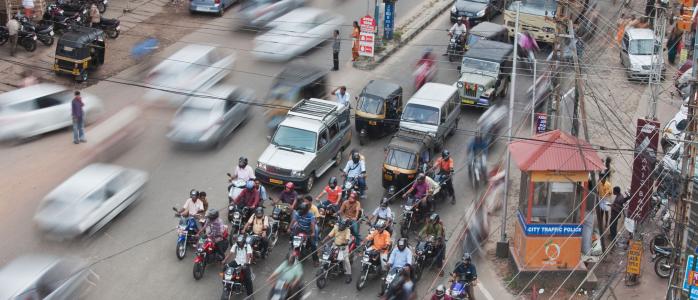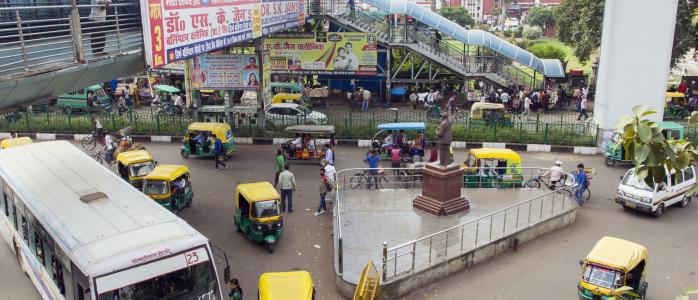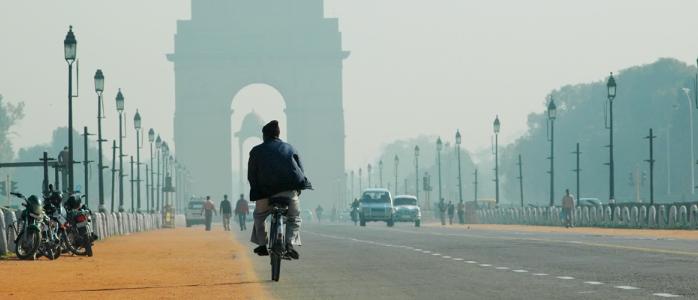



Indians have rediscovered the joys of cycling during the pandemic for their commute, local trips and leisure. In 2020, the number of cyclists on Delhi’s main thoroughfares increased by around 4 to 12 per cent.1 The bicycle industry in India saw sales doubling between May 2020 and September 2020 compared to the same period in 20192. Yet, India’s cycling infrastructure has failed to keep up with growing demand. Although we have national policies to facilitate non-motorised transport (NMT), no Indian city has enough NMT infrastructure to support safe cycling. Delayed project implementation is another major concern. For example, a 17-km pop-up cycling lane in Bengaluru was announced in June 2020 but only one-fourth of it was completed by January 20213.
Walking and cycling combined have the potential to reduce CO2 emissions by about 37 per cent by 20324. The cycling boom during the pandemic presents India with an excellent opportunity to promote this green mode of transportation. Here is a five-point roadmap for a cycling-friendly future.
1. Improve institutional capacity
India has around 8,000 towns and over 4 lakh villages but only 5,000 urban planners5. Urban Local Bodies (ULBs) are under-resourced and lack the capacity to plan, deliver, and maintain sustainable transport solutions. Cities need dedicated planning verticals staffed with trained physical planners, mobility planners and urban designers. The government must leverage schemes like the Atal Mission for Rejuvenation and Urban Transformation (AMRUT) and The Urban Learning Internship Program (TULIP, part of the Smart Cities Mission) to build and increase the ULB capacity. Further, transport and planning bodies in towns and rural areas must train their staff to ensure implementation of national policies, guidelines, and standards for sustainable transport.
2. Reallocate funds
Developing cycle tracks costs anywhere between INR 25 lakh/km to INR 146 lakh/km, depending on the road width6. Their integration into road development projects increases costs by just 10 per cent. Thus, policymakers should reallocate a portion of budget funds earmarked for road development and maintenance each year for the construction of cycling tracks and footpaths.
3. Strengthen legal protection for cyclists
Cyclists are among the most vulnerable road users but do not receive commensurate protection under the law. The Rules of the Road Regulation, 1989, recognises their right of way and imposes obligations on motorists with respect to non-motorised traffic. But punitive measures are not severe. These should be amended to ensure that offenders who endanger cyclists’ lives face legal prosecution. At the same time, law enforcement authorities and private citizens should work together to implement community policing. By recruiting volunteers to serve as ‘Bicycle Buddies’, communities can help their members cycle safely, engage their youth in awareness campaigns, and encourage more people to take up cycling.
4. Develop people-oriented mobility
Mobility is a social justice issue in India. The poor planning and implementation of sustainable public and non-motorised transport projects affect captive users, including low-income groups, children, and women. To develop a culture of integrated, people-oriented mobility, India needs legislation that enables affirmative action for non-motorised transport (NMT) and guarantees its citizens the ‘right to mobility’. For example, a law introduced by Mexico City in 2014 prioritises citizens in mobility planning and establishes a mobility hierarchy for road-use planning and budget allocations. Pedestrians are on top, followed by cyclists. Private car owners come last. Another example is Singapore’s 2018 Active Mobility Act, which supports non-motorised transport (NMT) and builds a culture of courtesy and respect for vulnerable commuters. The BYCS India Foundation’s ‘Bicycle Mayors’ are actively pushing for such a law in their respective states7.
5. Democratic demand
The final piece of the puzzle is a democratic demand for better cycling infrastructure. A particularly instructive example comes from the Netherlands. When Dutch neighbourhoods were destroyed to create space for motorised traffic, casualties rose. In 1971, the year traffic accidents peaked, it claimed the lives of 400 children8. The fierce, massive, nationwide, women-led protests that followed paved the way for change. Today, Amsterdam is known as the bicycle capital of the world.
In India, owning a personal motor vehicle continues to be an aspiration for many people. About 55 per cent of the respondents from CEEW’s 2019 pan-India urban mobility survey claimed car ownership is important to them9. Cycle days in Bengaluru and car-free days in Chennai and Hyderabad are excellent examples of the positive impact of community engagement. Public Bike Sharing (PBS) schemes can help, too. A pilot launched in Chandigarh in December 2020, has garnered 11,000 regular users10. In Jabalpur, as many as 36,000 users completed 42,000 rides within a month of the launch in December 201811.
Although there are no cycle-able cities in India yet, boosting demand for bicycles and setting up cycling infrastructure are both critical to sustainable urban living. With strong political and community leadership, progress is possible.
Nilanshu Ghosh is a Research Intern and Harsimran Kaur is a Research Analyst and at The Council on Energy, Environment and Water (CEEW). Send your comments to [email protected]
References
1Soumya Pillai, “With Limited Public Transit, Cycling Picks up Speed in Delhi, Finds Study,” Hindustan Times, July 25, 2020,
https://www.hindustantimes.com/delhi-news/in-post-lockdown-delhi-cycling-is-picking-up-speed-finds-study/story-pKcgSlEs69JnvHcjEBrkhO.html.
2Business Today, “Cycle Sales in India Double in Last 5 Months amid Pandemic,” Business Today, October 14, 2020,
https://www.businesstoday.in/current/economy-politics/cycle-sales-in-india-double-in-last-5-months-amid-pandemic/story/418911.html.
3Christian Mathew Philip, “Bengaluru: Only One-Fourth of 17 km Cycle Lane Complete,” January 29, 2021,
https://timesofindia.indiatimes.com/city/bengaluru/only-one-fourth-of-17km-cycle-lane-complete/articleshow/80521099.cms.
4Madhur Maheshwari, Arnab Jana, and Santanu Bandyopadhyay, “Optimizing the Modal Split to Reduce Carbon Dioxide Emission for Resource-Constrained Societies,” Transportation Research Procedia, Recent Advances and Emerging Issues in Transport Research – An Editorial Note for the Selected Proceedings of WCTR 2019 Mumbai, 48 (January 1, 2020): 2063–73,
https://doi.org/10.1016/j.trpro.2020.08.266.
5UNESCO, “Global Education Monitoring Report 2019” (United Nations, 2018),
https://www.un-ilibrary.org/content/books/9789210476775.
6TRIPP, “Planning and Design Guideline for Cycle Infrastructure” (New Delhi: Transportation Research and Injury Prevention Programme at the Indian Institute of Technology, 2017),
https://shaktifoundation.in/wp-content/uploads/2017/06/NMT-Guidelines.pdf.
7BYCS India Foundation, “BYCS India Foundation,” BYCS India Foundation, accessed June 25, 2021
https://india.bycs.org/bmn.html.
8Renate van der Zee, “How Amsterdam Became the Bicycle Capital of the World,” The Guardian, May 5, 2015,
https://www.theguardian.com/cities/2015/may/05/amsterdam-bicycle-capital-world-transport-cycling-kindermoord.
9Abhinav Soman, Harsimran Kaur, and Karthik Ganesan, “How Urban India Moves: Sustainable Mobility and Citizen Preferences” (New Delhi: Council on Energy, Environment and Water, October 23, 2019),
https://www.ceew.in/publications/how-urban-india-moves.
10Munieshwer A Sagar, “Public Bike Sharing in Chandigarh: 11,000 Users Ride 35,000km in a Month, Save 11,617 Tonnes in Carbon Emissions,” Hindustan Times, January 18, 2021,
https://www.hindustantimes.com/cities/chandigarh-news/public-bike-sharing-in-chandigarh-11-000-users-ride-35-000km-in-a-month-save-11-617-tonnes-in-carbon-emissions-101610909525932.html.
11Jabalpur Smart City Limited, “Public Bike Sharing – Jabalpur Smart City,” Jabalpur Smart City Limited, accessed June 25, 2021,
http://jscljabalpur.org/public-bike-sharing/.






Add new comment